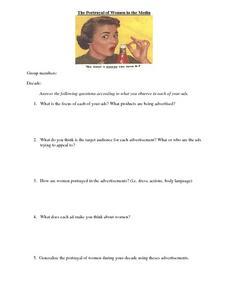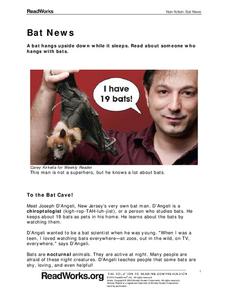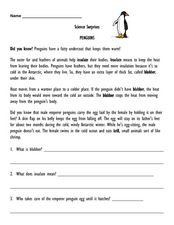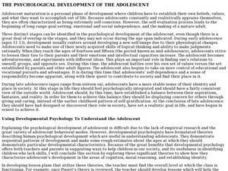Curated OER
34x25x36: Advertising and Body Image
Point of View’s short film, “34x25x36” launches a study of how images presented by mannequins and advertisements influence body image. Class members read and discuss the fact sheet "Media's Effect on Girls: Body Image and Gender...
Health Smart Virginia
How the Namuhs Learned to Be Content with Who They Are
Ninth graders consider how perceived standards of beauty influence body image as well as the relationship between body image and eating disorders. The class brainstorms traits the media presents as beauty standards for males and females,...
Cold Spring Harbor Laboratory
Sex Cells Have One Set of Chromosomes; Body Cells Have Two
What's the difference between body cells and sex cells? Learners explore the question and the process of meiosis using an interactive lesson. An animation describes the discovery of meiosis and describes its phases for a detailed and...
Curated OER
Owl Dance
Learners are introduced to a social dance from Canada's Aboriginal peoples. Students warm up listening to the music and listening for the beat before trying the 'Stomp' step without a partner. After some practice, learners choose...
Curated OER
The Portrayal of Women in Media
This is an awesome exercise. Learners use this worksheet as they examine an advertisement from a past decade (you need to provide). They answer five questions that aid them in analyzing the ad and the portrayal of women from that time...
Self-esteem fund
Self‑Esteem Activity Guide (For Youth Leaders of Young Girls)
Did you know that over 70 percent of girls avoid certain activities because they feel bad about their looks? This fantastic resource includes 18 tried and true activities designed to help girls establish positive self-esteem.
Biology Junction
Cnidarians and Ctenophorans
Cnidaria is a broad phylum of 11,000 different species from jellyfish to coral. Most Cnidarians are marine species with a few freshwater examples. A lesson presentation explains the important characteristics of different species of both...
LABScI
Circulation and Respiration: Vital Signs
What do your vital signs tell your doctor? An engaging hands-on lesson has your learners monitor their own lung capacity, blood pressure, and heart rate. They then connect the vital measures to the workings of the circulatory and...
Nemours KidsHealth
Eating Disorders: Grades 3-5
Explore the idea of self-esteem through different mediums. Research what is needed for increased self-esteem: list three things one might do well in, take a photo of an activity where each student is performing well, and examine how the...
Curated OER
Animal Colors and Shapes
Students investigate the natural characteristics of animals by completing a coloring activity. In this animal properties lesson, students investigate the reasons different animals have specific colors, and how it is essential for their...
Roland Park Country School
Butterfly or Moth?
What is the main difference between a moth and a butterfly? Butterflies have club-shaped antennae, while moths have a feather-like antennae. But what else differentiates these beautiful insects? The presentation in the resource provides...
American Museum of Natural History
What's This? Reproduction
Attracting the right mate is as important for humans as any other species. An interesting lesson teaches individuals about several strategies that animals and plants have adapted to attract their mates. From colorful nests to powerful...
Read Works
Bat News
Get the bat facts with a short nonfiction reading passage. After reading the passage, readers respond to questions that focus on main idea, inferencing, vocabulary in context, and author's purpose.
Curated OER
Building a Baby
Middle schoolers study the fetal development of humans. In this development lesson students divide into groups and research the different gestational weeks of a fetus.
Curated OER
Science Surprises: Penguins
In this reading comprehension worksheet, students read a 3 paragraph selection about penguins and then respond to 3 short answer questions.
Curated OER
Pablo Picasso
In this online interactive history instructional activity, students respond to 10 short answer questions about Pablo Picasso. Students may check some of their answers on the interactive instructional activity.
Curated OER
Gender Roles: Exposing Stereotypes
A series of activities help middle- and high-schoolers identify and explore gender stereotypes and how they can lead to violence and abuse. Use think-pair-share to activate whole class brainstorming about what it means to "be a man" and...
New Class Museum
Lesson: Elizabeth Peyton: Portraits: Androgyny in Contemporary Culture
Portraiture, artistic expression, romanticism, and androgyny are discussed in a thought-provoking lesson. Upper graders first discuss and examine the history of portraiture and the elements common to the Romantic style. Then they turn...
Curated OER
Feminism Does Not Have to be an F-Word
Students analyze social activism messages in music. For this feminism lesson, students explore selected music that expresses sentiments voiced in the women liberation movement in the United States. Students compare the lyrics of the...
Curated OER
The Physiological and Psychological Development of the Adolescent
Students examine the life of a teenager from their own perspective and an adult's. In groups, they focus on the biological changes and how they are different in a girl and a boy. Individually, they write a paper about these changes and...
Curated OER
Geometry: Practical Applications of the Distance Formula
Students, working independently and in groups, apply the distance formula to practical situations. After solving various problems, students in pairs design coordinate planes from the school blue print to measure the distance from the...






















